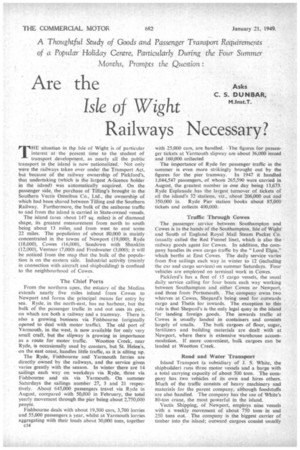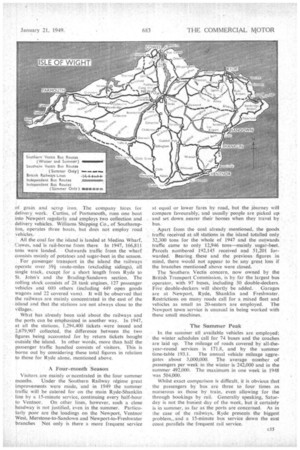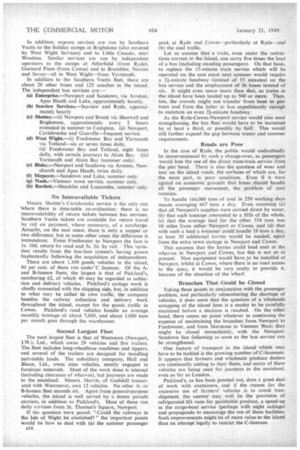Are the Asks
Page 20

Page 21

Page 22

If you've noticed an error in this article please click here to report it so we can fix it.
C. S. DUNBAR,
Isle of Wight M.1nst.T.
Railways Necessary?
THE situation in the Isle of Wight is of particular interest at the present time to the student of transport development, as nearly all the public transport in the island is now nationalized. Not only were the railways taken over under the Transport Act, but because of the railway ownership of Pickford's, that undertaking (which is the largest A-licence holder in the island) was automatically acquired. On the passenger side, the purchase of Tilling's brought in the Southern Vectis Omnibus Co., Ltd., the ownership of which had been shared between Tilling and the Southern Railway. Furthermore, the bulk of the seaborne traffic to and from the island is carried in State-owned vessels.
The island (area about 147 sq. miles) is of diamond shape, its greatest measurement from north to south being about 13 miles and from west to east some 22 miles. The population of about 80,000 is mainly concentrated in the towns of Newport (19,000), Ryde (18,000), Cowes (16,000), Sandown with Shanklin (12,000), Ventnor (7,000) and Freshwater (3,000); it will be noticed from the map that the bulk of the population is on the eastern side. Industrial activity (mainly in connection with aircraft and shipbuilding) is confined to the neighbourhood of Cowes.
The Chief Ports
From the northern apex, the estuary of the Medina extends nearly five miles inland from Cowes to Newport and forms the principal means for entry by sea. Ryde, in the north-east, has no harbour, but the bulk of the passenger traflic in and out uses its pier, on which are both a railway and a tramway. There is also a growing business via Fishhourne (originally opened to deal with motor traffic). The old port of Yarmouth, in the west, is now available for only very small craft, but the slipway is growing in importance as a route for motor traffic. Wootton Creek, near Ryde, is occasionally used by coasters, but St. Helen's, on the east coast, handles little traffic, as it is silting up.
The Ryde, Fishbourne and Yarmouth ferries are directly owned by the railways, and the service given varies greatly with the season. In winter there are 14 sailings each way on weekdays via Ryde, three via Fishbourne and six via Yarmouth. On summer Saturdays the sailings number 27, 3 and 21 respectively. About 645,000 passengers travel via Ryde in August, compared with 50,000 in February, the total yearly movement through the pier being about 2,750,000 people.
Fishbourne deals with about 19,500 cars, 3,700 lorries and 55,000 passengers a year, whilst at Yarmouth lorries aggregating with their loads about 30,000 tons, together c14 with 25,000 cars, are handled. The figures for passenger tickets at Yarmouth slipway are about 36,000 issued and 160,000 collected
The importance of Ryde for passenger traffic in the summer is even more strikingly brought out by the figures for the pier tramway. In 1947 it handled 1,044,547 passengers, of whom 265,590 were carried in August, the greatest number in one day being 13,673. Ryde Esplanade has the largest turnover of tickets of all the island's 32 stations, viz., about 206,000 out and 350,000 in. Ryde Pier station books about 85,000 tickets and collects 400,000.
Traffic Through Cowes The passenger service between Southampton and Cowes is in the hands of the Southampton, Isle of Wight and South of England Royal Mail Steam Packet Co. (usually called the Red Funnel line), which is also the railway goods agent for Cowes. In addition, the company handles its own cargo traffic by the "Lord Elgin," which berths at East Cowes. The daily service varies from five sailings each way in winter to 12 (including the car and cargo services) on summer Saturdays. Four vehicles are employed on terminal work in Cowes.
Pickford's has a fleet of 15 cargo vessels, the usual daily service calling for four boats each way working between Southampton and either Cowes or Newport, and three from Portsmouth. The company owns two wharves at Cowes, Shepard's being used for outwards cargo and Thetis for inwards. The exception to this rule is that Shepard's is the only legal quay in the island for landing foreign goods. The inwards traffic at Cowes is usually landed in containers and consists largely of smalls. The bulk cargoes of flour, sugar, fertilizers and building materials are dealt with at Newport, where there is extensive warehouse accommodation. If more convenient, bulk cargoes can be landed at Wootton Creek.
Road and Water Transport
Island Transport (a subsidiary of J. S. White, the shipbuilder) runs three motor vessels and a barge with a total carrying capacity of about 500 tons. The company has two vehicles of its own and hires others. Much of the traffic consists of heavy machinery and materials for the parent company, although foodstuffs are also handled. The company has the use of White's 80-ton crane, the most powerful in the island.
Vectis Shipping, of Newport, employs nine vessels with a weekly movement of about 750 tons in and 250 tons out. The company is the biggest carrier of timber into the island; outward cargoes consist usually
of grain and scrap iron. The company hires for delivery work. Curtiss, of Portsmouth, runs one boat into Newport regularly and employs two collection and delivery vehicles. Williams Shipping Co., of Southampton, operates three boats, but does not employ road vehicles.
All the coal for the island is landed at Medina Wharf, Cowes, and is rail-borne from there In 1947, 166,811 tons were landed. Outwards traffic from the wharf consists mainly of potatoes and sugar-beet in the season.
For passenger transport in the island the railways operate over 594 ioute-miles (excluding sidings), all single track, except for a short length from Ryde to St. John's and the Brading-Sandown section. The rolling stock consists of 28 tank engines, 127 passenger vehicles and 600 others (including 449 open goods wagons and 22 covered vans). It will be observed that the railways are mainly concentrated in the east of the island and that the stations are not always close to the villages. •
What has already been said about the railways and the ports can be emphasized in another way. In 1947, at all the stations, 1,294,400 tickets .were issued and 2,679,907 collected, the difference between the two figures being accounted for by return tickets bought outside the island. In other words., more than half the passenger traffic handled consists of visitors. This is borne out by considering these total figures in relation to those for Ryde alone, mentioned above.
A Four-month Season
Visitors are mainly crncentrated in the four summer months. Under the Southern Railway regime great improvements were made, and in 1949 the summer traffic will be catered for on the main Ryde-Shanklin line by a 15-minute service, continuing every half-hour.
to Ventnor. On other lines, however, such a close headway is not justified, even in the summer. Particularly poor are the loadings on the Newport, Ventnor West, Merstone-to-Sandown and Newport-to-Freshwater branches Not only is there a more frequent service at equal or lower fares by road, but the journey will compare favourably, and usually people are picked up and set down nearer their homes when they travel by bus.
Apart from the coal already mentioned, the goods traffic received at all stations in the island totalled only 32,300 tons for the whole of 1947 and the outwards traffic came to only 12,946 tons—mainly sugar-beet. Parcels numbered 192,145 received and 51,201 forwarded. Bearing these and the previous figures in mind, there would not appear to be any great loss if the branches mentioned above were closed.
The Southern Vectis concern, now owned by the British Transport Commission, is by far the largest bus operator, with 97 buses, including 30 double-deckers. Five double-deckers will shortly be added. Garages are at Newport, Ryde, Shanklin and Freshwater. Restrictions on many roads call for a.mixed fleet and vehicles as small as 20-seaters are employed. The Newport town service is unusual in being worked with these small machines.
The Summer Peak
In the summer all available vehicles are employed: the winter schedules call for 74 buses and the coaches are laid up. The mileage of roads covered by all-theyear-round services is 171.8, and by the summer
time-table I93A. The annual vehicle mileage aggregates about 3,000,000. The average number of passengers per week in the winter is 242,000 and in the summer 492,000. The maximum in one week in 1948 was 504,000.
Whilst exact comparison is difficult, it is obvious that the passengers by bus are three to four times as numerous as those by train, even allowing for the through bookings by rail. Generally speaking, Saturday is not the busiest day of the week, but it certainly is in summer, as far as the ports are concerned. As in the case of the railways, Ryde presents the biggest problem„ and a 15-minute bus service down the east coast parallels the frequent rail service.
In addition, expiess services are run by Southern Vectis to the tiolid.ay camps at Brighstone (also covered by West Wight Services) and to Little Canada, near Wootton. Similar services are run by independent operators to the camps at Atherfield (from Ryde), Gurnard Pines (from Cowes) and to Brambles, Norton and Savoy—all in West Wight—from Yarmouth.
In addition to the Southern Vectis fleet, there are about 20 other buses and 125 coaches in the island. The independent bus services are:—
(a) Enterprise.—Newport and Sandown, via Arreton, Apse Heath and Lake, approximately hourly.
(b) Seaview Services.—Seaview and Ryde, approximately hourly.
(e) Shotter.—(i) Newport and Brook via Shorwell and Brighstone, approximately every 2 hours extended in summer to Compton. (ii) Newport, Carisbrooke and Gunville—frequent service.
(d) West Wight.—(i) Freshwater Bay and Yarmouth via Tottand—six or seven times daily.
(ii) Freshwater Bay and Totland, eight times daily, with certain journeys to Alum Bay. (iii) Yarmouth and Alum Bay (summer only).
(e) Blake.—Newport and Sandown via Arreton, Newchurch and Apse Heath, twice daily.
(f), Meguyer.—Sandown and Lake, summer only. (g) Nash.—Ventnor town service, summer only. Bartlett—Shanklin and Luccombe, summer only.
No Interavailable Tickets Messrs. Shotter's Carisbrooke service is the only one *where there is time-table co-ordination; there is no Interavailability of return tickets between bus services. Southern Vectis tickets are available for return travel by rail on payment, where necessary, of a surcharge. Actually, on the east coast, there is only a copper or two difference, but in some other eases the difference is tremendous. From Freshwater to Newport the fare is is. 10d. return by road and 3s. 3d. by rail. This variation results from the bus-fare system's having grown haphazardly following the acquisition of independents.
There are about 1,100 goods vehicles in the island, 80 per cent, of them run under'C licences. Of the Aand B-licence fleets, the largest is that of Pickford's, numbering 62, of which 40 may be regarded as collection and delivery vehicles. Pickford's cartage work is chiefly connected with the shipping side, but, in addition to what may be caned its own traffic, the company handles the railway collection and delivery work throughout the island, except for the goods traffic in Cowes. Pickford's road vehicles handle an average monthly tonnage of about 7,000, and about 1,000 tons per month goes through the warehouses.
Second Largest Fleet The next largest fleet is that. of Westrnore (Newport, LW.), Ltd., which owns 29 vehicles and five trailers. The fleet includes long-wheelbase machines and tippers, and several of the trailers are designed for handling indivisible loads. The subsidiary company, Hall and 'Mann, Ltd., owns nine vehicles, mostly engaged in furniture removals. Most of the work done is internal (including clearance of wharves), but journeys are made to the mainland. Messrs. Morris, of Godshill (associated with Westtnore), own 12 vehicles. No other Aor B-licence fleet exceeds six. Apart from general-purpose vehicles, the island is well served by a dozen parcels carriers, in addition to Pickford's. Most of these run daily smvices from St. Thomas's Square, Newport.
If the question were posed: "Could the railways in the Isle of Wight be abolished?" the important points would be how to deal with (a) the summer passenger c16 peak at Ryde and Cowes—particularly at Ryde—and (b) the coat traffic.
Let us assume that a train, even under the restrictions current in the island, can carry five times the load of a bus (including standing passengers). On that basis, to replace the 15-minute train service which will be operated on the east coast next summer would require a 21-minute headway (instead of 15 minutes) on the bits service and the employment of 36 buses instead of six. It might even mean more than that, as trains in the island have been loaded up to 500 or more. Then, too, the crowds might not transfer from boat to pier tram and from the latter to bus expeditiously enough to maintain an even 21-minute headway. . .
As the Ryde-Cowes-Newport service would also need strengthening, the bus fleet would have to be increased by at least a third, or possibly by half. This would still further expand the gap between winter and summer requirements.
Roads are Poor In the case of Ryde, the public would undoubtedly be inconvenienced by such a change-over, as passengers would lose the use of the direct tram-train service from the pier head. There is also the question of wear and tear on the island roads, the surfaces of which are, for the most part, in poor condition. Even if it were agreed on economic grounds that buses should handle all the passenger movement, the problem of coal remains.
To handle 166,000 tons of coal in 250 working days means averaging 667 tons a day. Even assuming (a) that all Newport's supplies were carried direct by water, (b) that such tonnage amounted to a fifth of the whole, (c) that the average lead for the other 534 tans was 10 miles from either Newport or Cowes, and (d) that with such a lead a 6-tonner could handle 18 tons a day, at least 30 additional lorries would be needed, apart from the extra town cartage in Newport and Cowes.
This asSumes that the lorries could load coal at the wharves in Newport and Cowes, but this is not so at present. New equipment would have,to be installed at Newport, whilst at Cowes, where there is no road access to the quay, it would be very costly to provide it, because of the situation of the wharf.
Branches That Could be Closed
Taking these points in conjunction with the passenger problem, and particularly remembering the shortage of vehicles, it does seem that the question of a wholesale scrapping of the island lines is a matter to be carefully examined before a decision is reached. On the other hand, there seems no point whatever in continuing the expense of maintaining the branches from Newport to Freshwater, and from Merstone to Ventnor West; they might be closed immediately, with the NewportSandown line following as soon as the bus service can be strengthened.
One feature of transport in the island which may have to be tackled is the growing number of C-licensees. it appears that farmers and wholesale produce dealers are continually adding to their fleets, and many of these vehicles are being used for journeys to the mainland, even as far as London. •
Pickford's, as has been pointed out, does a great deal of work with containers, and if the reason for the excessive use of farmers' vehicles is to avoid transhipment, the answer may well be the provision of refrigerated lift vans for perishable produce, a speed-up in the cargo-boat service (perhaps with night sailings) and propaganda to encourage the use of these facilities. Such improvements might be of more value to the island than an attempt legally to restrict the C-licensee.




























